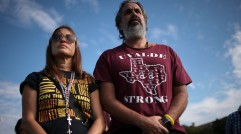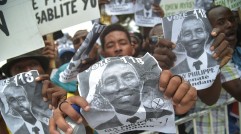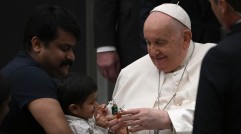Where are Latinos in the NFL Draft? Hispanic Players Overlooked Amid Growing Viewership of Football
Over 3,500 collegiate football players annually enter the NFL draft hoping to be one of about 200 selected, but only a fraction of which will ever kneel along an NFL sideline.
This year, top-10 quarterbacks Jared Goff and Carson Wentz are guaranteed lucrative signing bonuses that may tip $20 million, or somewhere close to the $17 million Jameis Winston got up front in 2015. First-rounders reap a luxury few other do: they cash in unconditional bonuses given before short or long-term deals are negotiated.
Second and third-rounder picks have a decent chance at cracking opening day rosters, but they -- like anyone awaiting their fate late into the three-day event -- are initially assured little more than a workout.
Most prospects come from prestigious football programs accepting of a diverse student body. Most played alongside Latinos, Asians and Native American minorities. Most selected this weekend, however, will either be white or African-American.
Latinos in the NFL Draft
Latinos accounted for 1.8 percent of Division I football players in 2012, compared to 51.6 percent African-Americans and 43.3 percent whites, according to The Institute for Diversity and Ethics in Sports (TIDES) at the University of Central Florida. This translates to the NFL, where Hispanics make up just 1.06 percent of the population; one estimate found a mere 26 Latino players held active roster spots during one week last season.
The 2016-17 season should be more of the same.
Only four Latinos have decent draft prospects: Oklahoma cornerback Zack Sanchez, Stanford linebacker Blake Martinez, UCLA wide receiver Thomas Duarte and Florida State kicker Roberto Aguayo. Aguayo is the most accurate kicker in NCAA history, converting 198 straight extra-point attempts and 88.5 percent of field goals, but he plays a position few are willing to take a flyer on.
Sanchez has tremendous upside following a Sooner career that placed him among the Oklahoma's all-time interception leaders. The son of a father from Chihuahua, Mexico, Sanchez is arguably the premier Latino featured, yet he wasn't projected for Thursday's first-round.
Standing in his way of a first or second-round selection are five other defensive backs, and a NFL draft historically void of any Spanish-speakers.
Dallas quarterback Tony Romo, New York Giants wideout Victor Cruz and former Houston running back Arian Foster -- whose mom is Mexican-American -- reached NFL stardom despite going undrafted. Detroit lineman Manny Ramirez was selected in the 4th round of the 2007 draft and has 83 games under his belt. Others, like hall of famer Anthony Munoz and soon-to-be hall of famer Tony Gonzalez, could have succeeded whether they were the top pick or 500th overall.
The draft is not indicative of future success, nor does it prophesize any one player -- Latinos included -- makes a 53-man roster.
But the low rate of participants indicates one of two things; either Hispanics don't want to play professional football or the NFL isn't telling them otherwise.
Community Outreach Efforts
In 2015, NFL games averaged about 1.7 million Latino viewers, a 12 percent increase from the 2012 season. Spanish-language-dominant viewers made up 25 percent.
Taking their analysis a step further, Nielsen averaged viewership of the last five Super Bowls, excluding the most recent one, last February, and found 11.2 million were Latino and 3.4 million were considered Spanish-dominant.
This is a result of massive media efforts over the last decade. Teams have Spanish-language websites now. They broadcast games on Spanish-language radio stations. Fox Sports en Español, ESPN Deportes and Telemundo all feature NFL programing, including exhibition games in Mexico.
Every September, the NFL celebrates Hispanic Heritage Month with recognition the impact Latino leaders have on their communities.
"Latino players, fans, and coaches have a strong sense of pride not only in their culture but in their team and the NFL," read a September 2015 press release, adding that the league's goal is to "amplify the rich history, heritage and tradition of Latinos, and honor the positive impact they have had on the game and country."
The U.S. Hispanic population reached 55.4 million in 2014, continuing a trend destined to make them the majority by 2050. The population increase may be tied to an increase in viewership, but greater access to games hasn't drawn more interest in minorities to play.
The TIDES-UCF report details how university leadership is predominately white, bereft of women and minority authority. As of 2012, Football Bowl Subdivision institutions -- those who can qualify for notable college games like the Rose Bowl and Sugar Bowl -- only carried two Latino presidents, four athletic directors, and two head coaches.
The dearth of Latinos in the NFL draft begins with mentors, coaches and communities they grow up with. NFL officials need to reach out to the Hispanic fan base like never before. Doing so means setting the league of for long-term success among all ethnicities.
Subscribe to Latin Post!
Sign up for our free newsletter for the Latest coverage!
* This is a contributed article and this content does not necessarily represent the views of latinpost.com














